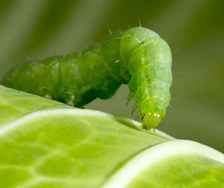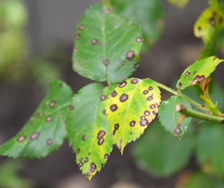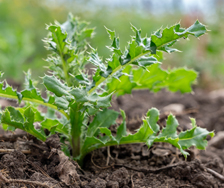Yates Account
Join now
Create a Yates account today!
Sign up to join the Yates Garden Club for monthly e-mails packed with seasonal inspiration, tips for success & exclusive promotions.
Plus if you’re a Garden Club member you can take part in the Yates Growing Community - a blog to share successes, get advice & win prizes in fun challenges along the way!

Forgot password
Enter the email address associated with your account, and we'll email you a new password.

Hybrid seeds seem to have a stigma for some home gardeners, which is a shame because they offer a lot of advantages. We’ve encountered some confusing and misleading information in circulation about hybrid seed, so hopefully if we clarify what they’re all about, it will demystify them a little.
We’d like to briefly explain what hybrids are and offer a balanced view on their benefits. We’ll need to dive into some Science™, so please bear with us!
What is a hybrid?
First of all, we need to explain the terminology so this makes sense.
A group of genetically similar plants, that has developed by natural means, is called a variety. Varieties typically remain true to type over many generations, so they stay pretty stable over time. This means that collecting seed and replanting in following seasons produces plants with similar characteristics to the generations before (similar but not identical, because their genes are randomly rearranged ever-so-slightly with every generation; over time this is known as ‘genetic drift’).
A plant that has been produced by selective breeding, with human intervention, is called a cultivar. Confusingly, many treasured heirloom varieties are technically cultivars because they were originally produced by selective breeding!
Defining a hybrid seed is pretty simple, it’s a cross between two genetically different plants from compatible species. The parents of man-made hybrids are specifically chosen, to generate desirable traits in their offspring plants. This offspring is called a first-generation hybrid, or ‘F1’.
Again, confusingly, not all hybrids are cultivars, because it’s quite normal for hybrids to occur in nature, without human intervention. For a local example close to our hearts, DNA testing on Great Spotted Kiwi museum specimens collected back in the 1870s revealed they are actually hybrids! There are five different species of kiwi, so in places where the populations overlapped, they were hybridising naturally. It seems kiwis have always been keen on mixing it up a bit.

The parent plants of open-pollinated seeds are pollinated by insects or wind, rather than people. They can be either varieties, or cultivars. If they’ve been established favourites for longer than 50 years, they qualify as 'heirlooms'.
F1 hybrids are much more labour-intensive to produce, as they usually have the pollination process strictly controlled so their seeds are all consistent. This explains why hybrids tend to be more expensive than open-pollinate varieties. Rather than sitting back and letting bees do the work, breeders need to enclose the parent plants in bags or sealed environments to stop unwanted pollen getting to them, so they often need to be hand pollinated. If male flowers can’t be manually removed, breeders have to use plants with sterile male stamens to prevent self-pollination affecting the cross. This all requires a lot of extra effort.
Clever hybridisation is all about carefully choosing the parent plants, with the most desirable cross being picked out from extensive trial combinations. After that begins a process of selection over multiple generations of the parents to get them to breed true to type - which can take years to complete (another reason for hybrids to cost more). The intention is that the chosen parents both contribute specific, targeted characteristics to their offspring, for a payoff of consistently superior performance.
F1 hybrids do have a limitation; their offspring (known as F2 hybrids) usually turn out different to their parents. Because the dominant genetic traits of the parents rearrange and assert themselves, it’s a bit hit-or-miss when saving seed from hybrid plants. It’s quite common for F2 hybrids to retain very good characteristics, but it’s a bit of a lucky dip!

Why go to all the trouble? Hybrid advantages
A key reason for the popularity of hybrids is hybrid vigour, or ‘heterosis’. This naturally happens when genetically diverse parents both contribute useful genes to their offspring, that combine to give the child larger size, faster growth and more resilience than its parents. The effect is greater than the sum of its parts: the more the parents genetically differ, the more pronounced the effect of hybrid vigour. This is Nature’s way of maintaining the health of a species, by widening the pool of its genetic diversity. It explains why a lot of us humans carry the imprint of Neanderthal or Denisovan ancestors in our genes – at some point in the distant past, these different species were getting together to make hybrid humans! It’s interesting to note that hybrid vigour only occurs with first generation (F1) hybrids.
Hybrid vigour was first observed by Charles Darwin; Gregor Mendel (pioneer plant breeder and founder of the science of genetics) quickly proved the truth of his theory with experimental field trials. Generations of breeders have contributed to the science behind hybrids since those early steps. The global supply of food has improved enormously, thanks to hybrid grains and vegetables.

Real world benefits
So that’s all the science out of the way – but what are the practical benefits? As mentioned, hybrid vigour is one bonus, but there’s a big list of gains that breeders are striving for, which may include any of the following:
- Improved germination rate
- Faster growth and earlier harvest
- Larger and consistently sized produce
- Better flavour
- Higher yields
- Enhanced resistance to stress (e.g., drought tolerance)
- Resistance to specific diseases (e.g., clubroot, viruses)
- Delayed ‘bolting’ to seed
- Longer fruiting season
- Consistent time to maturity
- Parthenocarpy (the ability to self-pollinate if there aren't any bees around)
- Suppressing ‘blind’ tendencies that can prevent brassicas from forming heads
Traditionally home gardeners have favoured open-pollinate ‘old favourite’ varieties, because there are usually more seeds in the packet and they can save seed successfully. Here’s some food for thought; we think hybrid seed is often a superior choice for the home vegie gardener because they’re more dependable. In return for the higher price, hybrids have been purpose-bred to deliver real, proven benefits. If you’re relying on the outcome, hybrids give you more surety and confidence; that's why commercial growers insist on F1 hybrids.

Mythbusting!
There’s a common misconception that hybrids don’t taste as good as old-fashioned heirlooms because they are bred for commercial growers, so flavour takes a back seat. This just isn’t accurate. Great taste is a key commercial benefit, because 21st Century consumers are more discerning than ever before; commercial growers are very aware of this, so flavour is near the top of the list of breeding traits. Also, the hybrids we offer are hand-picked to appeal to home gardeners, so great taste is a fundamental requirement to make it into our range.
We’ve seen a few ‘out-there’ opinions online about hybrids. For the record, we’d like to reassure everyone that our hybrids haven’t had “enzyme blockers” added to them. Likewise, our hybrids aren’t “depleted of nutrients”. Both of these statements deserve eyerolls.
As for suggestions that hybrids can contain genetically modified material, that’s simply not true in New Zealand. Hybrids have absolutely no connection with genetically modified organisms (GMOs), because hybrids are bred naturally, whereas GMOs are not. It doesn’t make sense to draw a line between them, they are very different things.
When we see claims that try to link hybrids with gene engineering, our first response is a deep sigh. The only thing we can suggest is to keep an open mind. If something you read sounds really alarming, or suggests that you're being lied to, it isn't automatically true. We encourage everybody to stay curious and ask questions.
Here's an example of what we mean. We spotted a claim that hybrids are allowed to be sneakily gene-modified because of a 'loophole' in USDA regulations. The claim uses technical jargon to argue it’s point; it seems like expert knowledge, so at face value it looks genuine…until you look a bit closer. The claim refers to a natural genetic trait of plants known as ‘cytoplasmic male sterility’ (CMS). This trait is an important tool for hybrid plant breeders, to prevent self-pollination from affecting the outcome of their crosses. So far, so good. But - the claim goes on to define CMS as an artificial process, that’s carried out with genetic engineering techniques. This is wildly inaccurate; CMS is simply a form of male sterility that’s inherited down the maternal line, that causes all the male offspring to be sterile as well. The important part is that male-sterile plants are still fertile – they can still produce viable seed that grows into new plants; they just have to use pollen from another male plant to do it (because what CMS really means is they can’t self-pollinate). The truth is, CMS is a natural mutation. It was first identified back in the 18th Century before anyone even dreamed of genetic engineering - CMS occurs in nature all the time. When you look past the tech jargon and consider the substance of the claim, it turns out to be nonsense.
The law in NZ is very clear: importing GMOs is illegal without specific permission from EPA (permission is rarely granted and is extremely unlikely for GMOs that would be released into the environment). Bringing GMOs into NZ would contravene Ministry of Primary Industries (MPI) import regulations, which are strictly enforced at our borders. Home gardeners in NZ really don’t need to worry about genetically modified seed, we are well protected by our Biosecurity agencies.
And just to be super-clear, Yates seeds are not genetically modified, in any way.

















Share
Share this article on social media